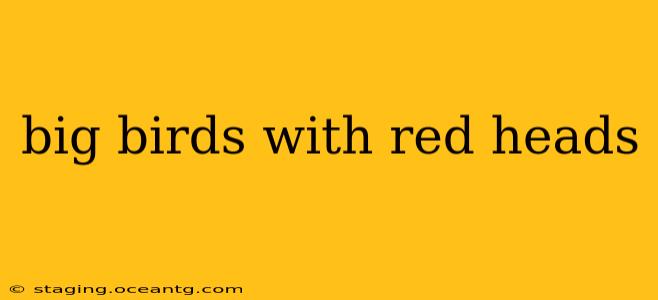Many magnificent birds boast striking red heads, making identification a fascinating challenge for birdwatchers of all levels. This guide explores some of the most captivating species, delving into their unique characteristics, habitats, and behaviors. We'll answer common questions and provide helpful tips to distinguish these feathered friends.
What are some big birds with red heads?
Several large bird species showcase vibrant red heads. Some prominent examples include:
-
Red-headed Woodpecker: This medium-sized woodpecker is instantly recognizable with its entirely red head, contrasting sharply against its black and white body. They're found in woodlands across North America, often seen perching on dead trees or fence posts.
-
Northern Cardinal (Male): While not as overwhelmingly large as some other species on this list, the male Northern Cardinal is a common and beloved sight. Its vibrant crimson head and crest, combined with its reddish body and black mask, make it easily identifiable. They inhabit a wide range across North America, frequenting gardens and shrubbery.
-
Pileated Woodpecker: This impressive, large woodpecker features a striking crimson crest on its head, a bold black body, and white stripes along its face. Their range extends throughout North America, favouring forests with mature trees. Their loud calls are unmistakable.
What kind of bird has a big red head and a long neck?
This description might point towards several species, depending on the overall size and location. However, some possibilities include:
-
Various Heron Species: Several heron species, such as Great Blue Herons and Great Egrets, while not necessarily having entirely red heads, often display reddish-brown or chestnut tones on their heads and necks, particularly during breeding season. Their long necks are a defining feature. Size can vary greatly depending on the species.
-
Some Crane Species: Certain crane species exhibit red coloration on their heads and necks, coupled with their characteristic long necks and legs. However, the exact shade and pattern of red will vary depending on the specific crane species.
What bird has a red head and a long beak?
A red head and a long beak could describe:
-
Scarlet Tanager: While not massive in size, the male Scarlet Tanager possesses a striking crimson head and body, with black wings and tail. It has a relatively long, slightly curved beak, ideal for its insectivorous diet. These birds are found in deciduous forests across eastern North America.
-
Ibises (depending on species): Certain ibis species, especially during breeding season, can display reddish or chestnut tones on their head and neck, combined with their distinctive long, down-curved beaks.
What is a big bird with a red head and a long tail?
The combination of a red head, large size, and long tail isn’t as common as other combinations. More information about the bird's overall shape and habitat would be needed for accurate identification. Consider the possibility that the red head might only be a patch of red rather than the whole head being red.
How can I identify a big bird with a red head?
Identifying a large bird with a red head requires careful observation of several features:
- Size and Shape: Note the bird's overall size compared to other birds in the area. Measure its size (if possible) and take note of its body shape (slender, stout, etc.).
- Coloration: Pay close attention not only to the red on the head but also to other colors on the body, wings, and tail.
- Habitat: The location where you observe the bird provides crucial clues. Is it in a forest, wetland, grassland, or other environment?
- Behavior: Observe its behavior: Is it foraging on the ground, perching in trees, flying, or exhibiting other notable actions?
- Vocalizations: If the bird vocalizes, attempt to record or describe the sounds, which can aid in identification.
- Use Field Guides and Apps: Employ bird identification field guides or apps (like Merlin Bird ID) to compare your observations with images and descriptions of various species.
By combining careful observation with reliable resources, you can confidently identify those big birds with striking red heads. Remember, patience and practice are key to mastering avian identification!
